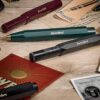This story originally appeared on the Gents Cafe Newsletter. You can subscribe here.
Founded in Sweden in 1928, ETON has made it its mission to perfect the dress shirt. The brand’s staple is, indeed, the white shirt—refined over the course of almost a century by balancing Scandinavian precision with Italian flair.
As the product offering broadened over the decades, other garments have been added to the collection—especially more contemporary shirts and blazers designed for a modern lifestyle. Still, the brand’s commitment to quality and respectful innovation has remained unchanged.
In this Brand Talks interview, ETON’s Collection Manager, Olof Enckell, shared the brand’s intention to “empower the modern man to be his best self” and explained how ETON keeps its heritage alive while always looking forward.

Can you tell us a bit about your background? What was your personal journey, and what led you to join ETON?
I actually studied economics, but I wasn’t particularly good at it. During my spare time, I started writing, which had always been a passion of mine. For nearly ten years, I worked as a freelance writer, focusing mainly on menswear. I was the editor of a Scandinavian digital magazine and also wrote for a few newspapers covering menswear. I did some freelance copywriting as well, but it was always more about the passion—both for writing and for well-crafted menswear. My interest has never really been in fashion in the traditional sense, but rather about the product itself, the craftsmanship behind it, the details. That’s what really excites me.
My journey with ETON started with a few freelance gigs. Then, about twelve years ago, I officially joined the company, working on the e-commerce platform, primarily handling content. About seven years ago, I transitioned to working with the product, and now I’m the Collection Manager.
It hasn’t been the most straightforward career path, but it’s been a journey. What helped me a lot was my background in writing and editing: those roles gave me the chance to meet and interview people across the industry and learn from them. I absorbed so much knowledge, especially about products.
Besides your role at ETON, what personal passions or hobbies do you pursue and how do they influence the way you lead the brand?
I’ve got a family with two kids, so free time is definitely limited—but I do try to make space for a couple of passions. Running is a big one for me. It’s obviously great for my health, but beyond that, it’s one of the things I truly love doing. It’s where I clear my head.I often get my best ideas while I’m out on a run. I don’t think I’m unique in that—many people say the same. It’s not that I come back with a checklist of new strategies for ETON, but I do return with a fresh perspective. It helps me think differently, take a step back.
I also really enjoy woodworking. We have this small, very old summer house that we’re slowly renovating. It’s not exactly fine craftsmanship—we’re talking more practical, hands-on stuff—but I find it incredibly satisfying.
ETON was founded in 1928 in Sweden, nearly a century ago. What are the values and principles that have remained unchanged since the early days?
I’d say the biggest value that’s stayed consistent is quality. That’s really been at the heart of ETON since the beginning. Of course, quality can mean different things to different people: some see it as using the finest fabrics, others as creating long-lasting products. For us, it’s always been a combination of both.
We aim to deliver a premium, luxurious experience, but it’s just as important that our products are durable and stand the test of time. I think that balance is one of the key reasons ETON has been successful. We’re not a cheap brand, but we offer a very strong quality-to-price ratio. You’re getting a great product for what you pay, and if you look at it in terms of cost per wear over the years, then yes, it’s actually quite affordable.
I think that mindset has a lot to do with our Swedish heritage. Swedes are generally very pragmatic and practical, very focused on making things that work and last. Take Volvo, for example: it’s not the most luxurious car brand, but it’s a great product with longevity and practicality built in. That’s a similar philosophy we have at ETON.
That said, maintaining that balance between quality and durability has been a growing challenge, especially post-pandemic. We’ve seen sharp increases in costs across the board—from raw materials to fabrics to production and labor. And of course, there’s only so much the customer is willing to pay before it becomes a psychological barrier. But one of our strengths at ETON is how closely we manage product development, from raw materials all the way to the finished shirt. We also have long-term relationships with most of our fabric mills, which helps us maintain consistent quality and keep pricing fair.

ETON’s brand purpose speaks of empowering the modern man to be his best self—committed to excellence, personal growth, and positive impact. How do you translate that into your everyday decisions across design, communication, and company culture?
Our purpose as a brand is to offer garments that make our customer feel good, look good, and feel confident in his choices and how he presents himself. That’s really the essence of what we do.
Every time we create a product, we ask ourselves: Will the customer feel confident wearing this? Will he feel empowered? Well-dressed? That’s always the goal. It’s about keeping the customer at the center of every decision and making sure we develop products that are relevant and meaningful to him.
Since we focus solely on menswear, we have the opportunity to really hone in on what the modern man needs. And I think one great example of this connection is our white shirt. It’s probably our most iconic product, and often the first ETON piece someone buys. What’s really special is that it’s often bought for a key moment—like a wedding, a job interview, or even someone’s first big job. And when someone wears it and feels great in it, it becomes tied to a personal memory.
In the end, if our products aren’t being used, if they’re not bringing anything to the customer’s life, then they’re just garments. But when someone tells us, “I wore your shirt for a wedding, and I felt amazing”, that’s the kind of feedback that keeps us motivated.
Every time we create a product, we ask ourselves: Will the customer feel confident wearing this? Will he feel empowered? Well-dressed? That’s always the goal. It’s about keeping the customer at the center of every decision and making sure we develop products that are relevant and meaningful to him.
You define your aesthetic as ‘Swedish design with an Italian twist.’ How do you balance Nordic clarity and craftsmanship with that distinct Milanese sense of flair?
There are quite a few Nordic brands that are purely rooted in Scandinavian style—which is great in its own right. That minimalism, that clarity, has a strong identity. But what’s interesting about ETON is that while we come from a Nordic perspective, we also have a design team based in Italy who work very closely with our Italian fabric suppliers. That naturally brings a different energy into the process.
Italian style, much like Italian food, varies by region and has a lot of nuance. What we really embrace is the approach—especially their deep-rooted knowledge and innovation when it comes to textiles and quality. That’s something that complements the Swedish mindset perfectly.
In the end, it’s about combining two design cultures that push each other forward: the precision and restraint of the Nordics, and the richness and refinement of Italy. It creates something unique.

If you had to tell the story of ETON through three iconic pieces, which would you choose and why?
I’d start with the white shirt: it’s undoubtedly our most iconic item; it’s timeless, versatile, and has become part of so many people’s big moments.
The second would be the printed shirt. We’ve been doing printed dress shirts for over 25 years and were actually one of the first brands to introduce them in a formalwear context. To me, that shirt represents ETON’s ability to take a classic and inject it with personality—something playful and innovative, without losing elegance.
And third, I’d pick one of our newest pieces: a completely unlined blazer that reflects our ambition to offer a more complete look—a full wardrobe for the modern man. What I love about it, just like our shirts, is its versatility. You can dress it up with flannel trousers or tone it down with jeans. That kind of adaptability, to me, is key when talking about longevity and relevance in design. So those three pieces really span our legacy, innovation, and direction forward.

Your collections span from sharply tailored business shirts to casual t-shirts and overshirts crafted in refined materials. At first glance, they seem to serve very different purposes, but what’s the common thread that ties them all together?
In recent years, we moved away from thinking strictly in terms of product categories—like “this is a t-shirt” or “this is a polo”—and instead started focusing more on the customer. What does his wardrobe actually look like? What does he need across the different moments of his life? That’s become our guiding principle: understanding how the modern man dresses today and how we can support him with pieces that feel relevant, refined, and versatile.
Take the classic white shirt: it’s perfect in a business setting. But that same customer also goes on holiday, spends weekends with his family, or meets friends in more casual settings. We want to make sure ETON is part of those moments, too.
Fifteen years ago, a typical ETON customer might have owned ten of our shirts and paired them with suits from other brands. But today, dressing is more nuanced. He might wear a shirt and tie one day, and the next, layer the same shirt under a knitted sweater or an unstructured jacket. Our job is to provide the elements he needs to build that kind of flexible, contemporary wardrobe. It’s about offering new ways to wear our classics, while also expanding the wardrobe to suit the full rhythm of his life.

In a market where competition is strong, what do you think makes ETON products stand out?
If we take the white dress shirt as an example—which is really our cornerstone product—there isn’t one single element that makes it stand out. I wish I could say it’s just about having more stitches per inch or a specific collar construction, but the truth is, it’s the sum of many small details that we’ve perfected over time.
What really sets ETON apart is our heritage. Every element of our shirts has been fine-tuned over decades. We’ve constantly improved, adapted, and refined, and I think that mindset is key. From fabric quality to fit to how the shirt holds up throughout the day, we’re obsessed with getting it right.
Lately, we’ve worked on softening the aesthetic a bit—introducing new collar and cuff options, expanding the color palette, to align with how modern men are dressing. But even as we evolve, that commitment to detail and craftsmanship stays the same.
And honestly, I think that’s something you can’t replicate overnight. If a newer brand tried to copy an ETON shirt, they might get the look right, but without the years of small, thoughtful improvements behind it, they wouldn’t know how to make it better. That depth of knowledge and experience is what makes our products truly stand out.
Your recent collaboration with Tretorn brought together two iconic Swedish brands. What sparked the idea behind this partnership, and in what ways does it reflect the values you both stand for?
What we really appreciated about Tretorn is that we share a lot of the same core values. They’re an even older brand than we are, with a rich heritage, and of course, they’re also Swedish. But where ETON leans more into refined menswear, Tretorn is rooted in functional sportswear—most known for their iconic sneakers. The idea behind the collaboration was to see what would happen if we merged those two worlds.
When we started talking, we both went deep into our archives. Tretorn focused on their classic Nylite sneaker, which became the foundation for the collaboration. On our end, we explored old labels, logos, and vintage marketing materials. That research shaped the creative direction: bringing a tailored sensibility into sporty pieces, and giving heritage items a fresh, modern twist.
It’s been exciting because this collection took us into an entirely new territory: we’d never made sneakers, shorts, or trousers before. But that’s the beauty of collaborations. They give you a chance to experiment, to do something unexpected while still holding onto your standards. The response has been fantastic, and I think it’s because we were able to create something that felt fresh but still distinctly ETON in terms of quality and design ethos.

What does elegance mean to you today?
For me, elegance is really about feeling confident, comfortable, and natural in what you wear. You know that feeling when you put something on and it just doesn’t quite sit right—it might look good, but it doesn’t feel like you? That’s the opposite of elegance for me.
True elegance comes when a garment reflects who you are. It feels right, fits your personality, and gives you that sense of ease. It’s something you enjoy wearing, that feels good on the body, and that holds its quality throughout the day. That, to me, is the essence of an elegant piece—it stays sharp, wears well, and supports you without ever being distracting.
True elegance comes when a garment reflects who you are. It feels right, fits your personality, and gives you that sense of ease.

Is there a book, film, journey or place that has particularly inspired your life, or the direction you’ve taken with the brand?
When I was 18, I read a book called The Gentleman, and it was a real eye-opener for me. At that point, I didn’t know much about menswear, but the book introduced me to the world of craftsmanship, culture, and heritage that surrounds it. That really sparked something: it was my entry point into this whole world.
Another defining experience came shortly after starting at ETON, when I visited one of our suppliers in Italy. We went to a specialist in Como who makes our grenadine ties, and still uses traditional wooden looms that are nearly a century old, and seeing that level of dedication and heritage firsthand was incredibly inspiring.
That experience deepened my interest in product knowledge and made me understand how essential suppliers are—not just as part of the production process, but as partners who shape the quality and identity of the brand. It’s something that still drives me today. Working with people who carry that level of expertise and passion is a big part of why I love what I do.









